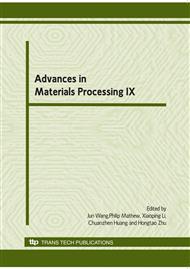p.382
p.388
p.394
p.400
p.406
p.411
p.417
p.423
p.428
Influence of Magnetic Field Strength on Polishing Effect of the Tiny-Grinding Wheel Cluster Based on the Magnetorheological Effect
Abstract:
A new tiny-grinding wheel cluster polishing method based on the Magnetorheological (MR) effect is presented to polish optical glass in this paper and some process experiments were conducted to reveal the influence of magnetic field strength, the content of carbonyl iron in the MR fluid and the speed of polishing disc on the material removal rate and the surface roughness of the glass workpiece. The results indicate that when the external magnetic field is applied, the material removal rate of the workpiece improves rapidly but the surface roughness increases slightly. When the Magnetic field strength is 100 Gs and the content of carbonyl iron is 3.5%, the material removal rate improves by a factor of 16.8% compared with that of the conventional polishing methods with dissociative abrasive particles, while the surface roughness of the workpiece increases unobviously.
Info:
Periodical:
Pages:
406-410
Citation:
Online since:
June 2010
Authors:
Price:
Сopyright:
© 2010 Trans Tech Publications Ltd. All Rights Reserved
Share:
Citation:


